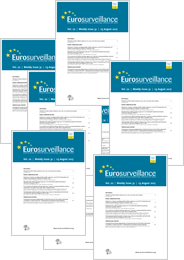- Home
- Weekly releases (1997–2007)
- Issue Home
Weekly releases (1997–2007) - Last IssueVolume 12, Issue 51, 20/Dec/2007
Volume 12, Issue 51, 2007
- Articles
-
-
-
Eurosurveillance – a look back at 2007
More LessThis year has been a very important milestone in the history of Eurosurveillance. The European Centre for Disease Prevention and Control (ECDC) took over the funding and production of the journal in March with the result that, for the first time since its launch in 1995, the whole editorial team began operating from a single location.
-
-
-
Multinational Salmonella Paratyphi B variant Java (Salmonella Java) outbreak, August – December 2007
J Denny , J Threlfall , J Takkinen , S Löfdahl , T Westrell , C Varela , B Adak , N Boxall , S Ethelberg , M Torpdahl , Masja Straetemans and W van PeltMore LessSalmonella Paratyphi B and Java are biovars of common serotype 1,4,[5], 12:b:1,2 which respectively cause human paratyphoid fever and gastroenteritis. The d-tartrate fermenting variant S. enterica subspecies enterica serovar Paratyphi B dT+ (formerly called and referred to in this report as S. Java) is thought to be less virulent to humans than the non d-tartrate fermenting variant, although cases of invasive infection have been reported.
-
-
-
Identification of Klebsiella pneumoniae carbapenemase in Sweden
More LessA Klebsiella pneumoniae expressing carbapenemase type 2 (KPC-2) enzyme has been identified in Sweden. The patient, who had a history of chronic obstructive lung disease, developed a respiratory tract infection while on holiday in Greece. After initial intensive care treatment in Greece, the patient was transferred to Sweden.
-
-
-
Ongoing outbreak of hepatitis A in Nis, Serbia: a preliminary report
More LessHepatitis A is still a great problem in developing countries, especially those in which vaccination is not obligatory. It is well known that hepatitis A is associated with risk factors such as poor sanitation and inadequate hygiene. However, some investigations (e.g. in Spain and Greece) showed that the seroprevalence of antibodies against hepatitis A virus (HAV) in recent decades has decreased, especially in the younger adults, most likely due to improvements in living standards and hygienic conditions.
-
-
-
Preparing the European Union for the next pandemic – half way there
More LessIn early 2005, the institutions and member states of the European Union (EU), together with the other European Economic Area (EEA) member states of Iceland, Liechtenstein and Norway, started preparing in a concerted manner for the next influenza pandemic.
-
-
-
Zoonotic infections in Europe: trends and figures - a summary of the EFSA-ECDC annual report
More LessThe 2006 annual Community Summary Report from the European Food Safety Authority (EFSA) and the European Centre for Disease Prevention and Control (ECDC) was released this week with the latest trends and figures on the occurrence of zoonotic infections and agents, antimicrobial resistance and food-borne outbreaks in the then 25 European Union Member States and five non-EU countries (Bulgaria, Iceland, Liechtenstein, Norway and Romania).
-
-
-
Training fellowships for intervention epidemiology in Europe
More LessThe European Centre for Disease Prevention and Control (ECDC) is recruiting for the 14th cohort of fellows in the European Programme for Intervention Epidemiology Training (EPIET), which will start in September 2008.
-
-
-
ECDC recruiting scientific experts
More LessThe European Centre for Disease Prevention and Control (ECDC) is inviting applications for the position of: Senior Expert for Respiratory Diseases in the Surveillance Unit Expert in Surveillance Unit – Antimicrobial Resistance and Healthcare-associated Infections
-
-
Most Read This Month Most Read RSS feed

-
-
Chikungunya in north-eastern Italy: a summing up of the outbreak
R Angelini , A C Finarelli , P Angelini , C Po , K Petropulacos , G Silvi , P Macini , C Fortuna , G Venturi , F Magurano , C Fiorentini , A Marchi , E Benedetti , P Bucci , S Boros , R Romi , G Majori , M G Ciufolini , L Nicoletti , G Rezza and A Cassone
-
- More Less


